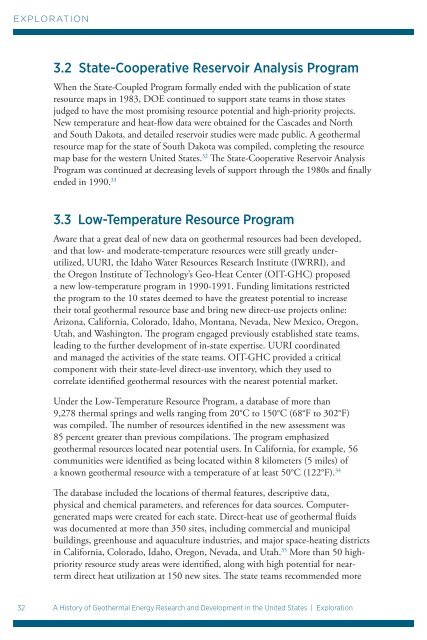A History of Geothermal Energy Research and Development in the ...
A History of Geothermal Energy Research and Development in the ...
A History of Geothermal Energy Research and Development in the ...
You also want an ePaper? Increase the reach of your titles
YUMPU automatically turns print PDFs into web optimized ePapers that Google loves.
EXPLORATION<br />
3.2 State-Cooperative Reservoir Analysis Program<br />
When <strong>the</strong> State-Coupled Program formally ended with <strong>the</strong> publication <strong>of</strong> state<br />
resource maps <strong>in</strong> 1983, DOE cont<strong>in</strong>ued to support state teams <strong>in</strong> those states<br />
judged to have <strong>the</strong> most promis<strong>in</strong>g resource potential <strong>and</strong> high-priority projects.<br />
New temperature <strong>and</strong> heat-flow data were obta<strong>in</strong>ed for <strong>the</strong> Cascades <strong>and</strong> North<br />
<strong>and</strong> South Dakota, <strong>and</strong> detailed reservoir studies were made public. A geo<strong>the</strong>rmal<br />
resource map for <strong>the</strong> state <strong>of</strong> South Dakota was compiled, complet<strong>in</strong>g <strong>the</strong> resource<br />
map base for <strong>the</strong> western United States. 32 The State-Cooperative Reservoir Analysis<br />
Program was cont<strong>in</strong>ued at decreas<strong>in</strong>g levels <strong>of</strong> support through <strong>the</strong> 1980s <strong>and</strong> f<strong>in</strong>ally<br />
ended <strong>in</strong> 1990. 33<br />
3.3 Low-Temperature Resource Program<br />
Aware that a great deal <strong>of</strong> new data on geo<strong>the</strong>rmal resources had been developed,<br />
<strong>and</strong> that low- <strong>and</strong> moderate-temperature resources were still greatly underutilized,<br />
UURI, <strong>the</strong> Idaho Water Resources <strong>Research</strong> Institute (IWRRI), <strong>and</strong><br />
<strong>the</strong> Oregon Institute <strong>of</strong> Technology’s Geo-Heat Center (OIT-GHC) proposed<br />
a new low-temperature program <strong>in</strong> 1990-1991. Fund<strong>in</strong>g limitations restricted<br />
<strong>the</strong> program to <strong>the</strong> 10 states deemed to have <strong>the</strong> greatest potential to <strong>in</strong>crease<br />
<strong>the</strong>ir total geo<strong>the</strong>rmal resource base <strong>and</strong> br<strong>in</strong>g new direct-use projects onl<strong>in</strong>e:<br />
Arizona, California, Colorado, Idaho, Montana, Nevada, New Mexico, Oregon,<br />
Utah, <strong>and</strong> Wash<strong>in</strong>gton. The program engaged previously established state teams,<br />
lead<strong>in</strong>g to <strong>the</strong> fur<strong>the</strong>r development <strong>of</strong> <strong>in</strong>-state expertise. UURI coord<strong>in</strong>ated<br />
<strong>and</strong> managed <strong>the</strong> activities <strong>of</strong> <strong>the</strong> state teams. OIT-GHC provided a critical<br />
component with <strong>the</strong>ir state-level direct-use <strong>in</strong>ventory, which <strong>the</strong>y used to<br />
correlate identified geo<strong>the</strong>rmal resources with <strong>the</strong> nearest potential market.<br />
Under <strong>the</strong> Low-Temperature Resource Program, a database <strong>of</strong> more than<br />
9,278 <strong>the</strong>rmal spr<strong>in</strong>gs <strong>and</strong> wells rang<strong>in</strong>g from 20°C to 150°C (68°F to 302°F)<br />
was compiled. The number <strong>of</strong> resources identified <strong>in</strong> <strong>the</strong> new assessment was<br />
85 percent greater than previous compilations. The program emphasized<br />
geo<strong>the</strong>rmal resources located near potential users. In California, for example, 56<br />
communities were identified as be<strong>in</strong>g located with<strong>in</strong> 8 kilometers (5 miles) <strong>of</strong><br />
a known geo<strong>the</strong>rmal resource with a temperature <strong>of</strong> at least 50°C (122°F). 34<br />
The database <strong>in</strong>cluded <strong>the</strong> locations <strong>of</strong> <strong>the</strong>rmal features, descriptive data,<br />
physical <strong>and</strong> chemical parameters, <strong>and</strong> references for data sources. Computergenerated<br />
maps were created for each state. Direct-heat use <strong>of</strong> geo<strong>the</strong>rmal fluids<br />
was documented at more than 350 sites, <strong>in</strong>clud<strong>in</strong>g commercial <strong>and</strong> municipal<br />
build<strong>in</strong>gs, greenhouse <strong>and</strong> aquaculture <strong>in</strong>dustries, <strong>and</strong> major space-heat<strong>in</strong>g districts<br />
<strong>in</strong> California, Colorado, Idaho, Oregon, Nevada, <strong>and</strong> Utah. 35 More than 50 highpriority<br />
resource study areas were identified, along with high potential for nearterm<br />
direct heat utilization at 150 new sites. The state teams recommended more<br />
32 A <strong>History</strong> <strong>of</strong> <strong>Geo<strong>the</strong>rmal</strong> <strong>Energy</strong> <strong>Research</strong> <strong>and</strong> <strong>Development</strong> <strong>in</strong> <strong>the</strong> United States | Exploration

















